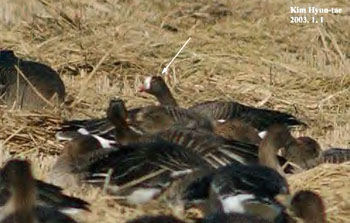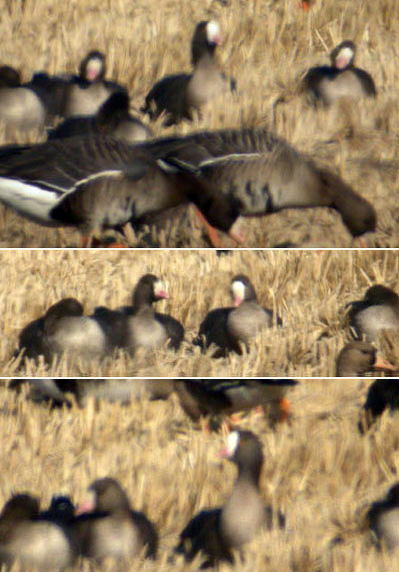Regular Migrant and Winter Visitor
Following the sighting of at least 11 Lesser White-fronted Geese Anser erythropus at Seosan in March 2004, this short note aims to review the records of this charismatic species in South Korea, providing some background information on status, comments on identification and distribution, and a list of records made in the winter of 2003/2004.
Global and Historical Status

The Lesser White-fronted Goose is listed by Birdlife International as Vulnerable, due to declines in the key breeding population in Russia of ca 20-40% over the past decade, and now has a world population estimated at less than 25 000- 30 000 individuals (Collar et al), with the vast majority of these wintering in China. Indeed recent survey effort found 16,600 Lesser White-fronted Goose in lakes in Hunan, Hubei, Jiangxi and Anhui Provinces over a 3-week period in January 2004, with the majority of these wintering regularly at Dongting (Mark Barter, Lei Gang, and Xu Qiang in lit., Kurechi Masayuki pers. com. in 2002). Considering the likely migration strategies of the species (with a series of records coming from as far east as Kamchatka for example), and its regular association with the confusingly similar but much more numerous Greater White-fronted Geese Anser albifrons (both when wintering and on migration), it was only to be expected that increasing coverage and especially observer experience would lead to a significant increase in South Korean records of erythropus.
Problems of Identification
Separation of the two "whitefronts", erythropus and albifrons, while very difficult at long range, is reasonably straightforward on medium-range or closer views, based both on diagnostic calls (once known) and a combination of size and especially structural differences, most particularly the rather smaller, triangular-shaped bill, and the smaller, squarer head shown by erythropus. Overall size (length and bulk) can also be a very good pointer of birds in mixed flocks (especially perhaps in eastern Asia where frontalis Greaters can appear significantly bulkier than typical erythropus) but must be used with the caveat that measurements of small juvenile albifrons can apparently still overlap those of the largest adult erythropus.

Joonam, 20 Jan 2004, Photo © Birds Korea/NM
Some further identification features highlighted in popular literature, which have perhaps both helped and hindered a good understanding of the species' status in Korea, include an over-reliance on the prominence of the eye-ring (a feature much more striking at some angles than others in erythropus, but also shown to a lesser degree by a significant percentage of presumably male albifrons); an over-emphasis on the extent of the white forehead blaze in erythropus (not always as apparent as suggested); and even also the often cited much less extensive black belly barring shown by erythropus adults when compared with albifrons. Personal experience (of a limited number of individuals) in South Korea suggests rather that there is a very wide variation in the amount of blackish barring on the underparts of erythropus, with some showing almost none, to one individual adult seen in March 2004 showing a solidly black belly - much more extensive and solid in appearance than any of the several thousand albifrons seen that day.
While identification of most individuals can be made confidently on the combination of a couple of key features, with bill shape and size clearly visible even in good views of flying birds, some individuals do remain puzzling even on longer views.
Two birds seen at Joonam in close association with an adult Lesser White-fronted, for example, appeared to show mixed characters of both erythropus and albifrons, suggesting hybridization. Both showed limited belly barring; extensive white on the forehead; and bright pink bills with extensive white nails - but also a head shape much closer to albifrons, with obviously larger and longer bills in direct comparison to the "pure" erythropus.
Status and Distribution of erythropus in South Korea: pre- the winter of 2003/2004
Based on personal observations and records gathered by the Birds Korea network, and allowing for the possibility of occasional misidentification, occasional hybridization, and patchy coverage of key areas, the Lesser White-fronted Goose should be considered a regular migrant and winter visitor to South Korea in small numbers, considerably more regular than suggested by the published literature. Recent records known to Birds Korea span the end of September to late March, with personal observations by the author suggesting that the majority of records are concentrated in two periods: mid-autumn, and again in late winter (especially in February and March).
All erythropus so far found have been in flocks of albifrons, with most records involving singles, but with several records of either family groups or small flocks (maximum suspected in one group was 10, at Seosan in early December 2003). Records have been made on both the west and south coast, and also inland in the southeast (with one further record known on the east coast, at Gangneung, in 2004). In all areas birds somewhat predictably roosted on lakes, wide rivers or estuaries and fed in adjacent rice-fields (with a tendency perhaps to feed in slightly drier fields than many other grey geese). Personal records pre- the 2003/2004 winter include: one or two in February and March at Ganghwa in the northwest (2003); singles on several occasions at Seosan (most winter months); 1 or 2 wintering at the Geum River, also on the west coast (at least in 1999, 2000 and 2001); several probables seen in the Haenam area (in 1999 and 2000); several (probably 4+) at Suncheon Bay in February 2002; 4 together with ca 500 Greater White-fronted Geese at the Nakdong estuary in February 1991; and further singles at Joonam Reservoirs in the Nakdong floodplain (with at least 2 present in 2001/2002), at least between December and February.
Records in the winter of 2003/2004
| Date | Number | Location | Observer |
| 30 Sept 2003 | | | "Swiss Team", NM |
| 4 Oct 2003 | | | DP, MS, NM |
| 5 Oct 2003 | | | DP, MS, NM |
| 15 Oct 2003 | | | "Swiss Team", NM |
| 31 Oct 2003 | | | DB and NM |
| 14 Nov 2003 | | | NM |
| 02 Dec 2003 | | | NM, CM |
| 09 Dec 2003 | | NM, CM | |
| mid-December 2003 | | | P J-G |
| 20 Jan 2004 | | NM, TE | |
| 01 March 2004 | | | C S-K |
| Early March 2004 | | | M I-H |
| 20 March 2004 | | | NM, PV, KH-T |
| 27 March 2004 | | | Via K H-T |
| 28 March 2004 | NM, KL, RL |
The rather greater number of records in the winter of 2003/2004 (linked it is considered most significantly to increased coverage in key periods) suggests even more clearly both that the Lesser White-fronted Goose occurs regularly in South Korea and that it is more of a migrant than an over-wintering species, with what appear to be quite distinct peaks in records in September and October (through to early December) and again in late February/March.
Table showing all records of Lesser White-fronted Goose in South Korea known to Birds Korea in the period September 2003 - March 2004.
Summary
The Lesser White-fronted Goose is a globally Vulnerable species, which has long been considered a very rare winter visitor to South Korea, even being classified as a vagrant by Lee, Koo and Park (2000). However, South Korea lies between breeding and wintering areas of at least some of Russia's ca 20 000 remaining breeding erythropus, and it appears that a combination of lack of coverage and lack of experience of the species has significantly limited the number of records being made.
Observations through the 1990s and especially since 2000 by the author and other experienced observers reveal that the species occurs annually in South Korea, with most records being made during migration periods, and rather fewer individuals appearing to remain through the winter.
Data remain too patchy to suggest with any level of confidence the number of Anser erythropus supported annually by South Korean wetlands but considering the low levels of coverage, the relatively small number of geese checked well compared to the numbers actually present, and the small numbers of observers confident enough to claim Lesser White-fronted Goose on brief or distant views, it is clearly likely that the number will be significantly higher than the 20-30 individuals identified in the winter alone of 2003/2004.
Acknowledgements
Nial Moores (NM) and Charlie Moores (CM) would like to acknowledge all observers listed in the table: "Swiss team" (Mathias Ritschard, Andreas Taechler, Claudio Koller, Diana Briel , Paul Walser, Mario Camici, Werner Mueller); Manuel Schweizer (MS), Dave Parmenter (DP), Dennis Buss (DB), Park Jong-Gil (P J-G), Tim Edelsten (TE), Choi Soon-Kyoo (C S-K), Mo In-Ho (M I-H), Kim Hyun-tae (K H-T), Ryan and Kara Lewantowicz (RL, KL).
References
- Collar, N. J., Andreev, A.V., Chan, S., Crosby, M.J., Sunbramanya, S. & J. Tobias (eds) Threatened Birds of Asia: The Birdlife International Red Data Book (online version, at http://www.rdb.or.id/pdf/anseeryt.pdf).
- Lee, W-S, Koo T-H & J-Y Park. (2000). A Field Guide To The Birds of Korea. LG Evergreen Foundation.
For more information on the Lesser White-fronted Goose and details of conservation projects go to the:



